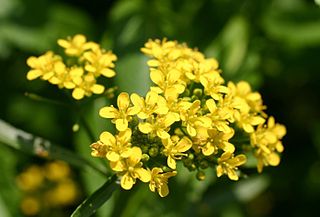
Rorippa is a genus of flowering plants in the family Brassicaceae, native to Europe through central Asia, Africa, and North America. Rorippa species are annual to perennial herbs, usually with yellow flowers and a peppery flavour. They are known commonly as yellowcresses.

Rorippa palustris, marsh yellow cress, is a species of flowering plant in the family Brassicaceae. It is widespread and native to parts of Africa, and much of Asia, Europe and Eurasia, North America and the Caribbean. It can also be found in other parts of the world as an introduced species and a common weed, for example, in Australia and South America. It is an adaptable plant which grows in many types of damp, wet, and aquatic habitat. It may be an annual, biennial, or perennial plant, and is variable in appearance as well.

Pyrrocoma carthamoides is a species of flowering plant in the family Asteraceae known by the common name largeflower goldenweed. It is native to western North America from British Columbia to northeastern California to Wyoming, where it is known from grassland, woodlands, forests, barren areas, and other habitat. It is a perennial herb growing from a taproot and producing one or more stems to about half a meter in maximum length, the stems reddish-green and leafy. The largest leaves are at the base of the stem, measuring up to 20 centimeters long, lance-shaped with spiny sawtoothed edges. Leaves higher on the stem are smaller and hairier. The inflorescence is a single flower head or a cluster of up to four. Each bell-shaped head is lined with phyllaries each up to 2 centimeters long. It has many yellow disc florets surrounded by a fringe of yellow ray florets up to 7 millimeters long; ray florets are occasionally absent. The fruit is an achene which may be well over a centimeter in length including its pappus.

Rorippa austriaca is a species of flowering plant in the family Brassicaceae known by the common names Austrian yellow-cress and Austrian fieldcress. It is native to parts of Europe and Asia, and it is known in North America as an introduced species and sometimes a noxious weed. It can grow in disturbed habitat, such as roadsides, and in very wet habitat such as mudflats. It is a perennial herb growing upright to erect, reaching a maximum height near one meter. The branching stem bears hairless blue-green lance-shaped leaves up to 10 centimeters long. The bases of the upper leaves clasp the stem. The inflorescence is a raceme at the top of the stem and the ends of stem branches. The mustardlike flowers have small yellow petals. The fruit is a plump silique a few millimeters long, but many plants do not fruit and seed production is rare. Reproduction in this species is more often vegetative, the plants concentrating their growth in belowground tissue and spreading clonally. The root system of the plant is particularly aggressive, sending up many new plants as it spreads.
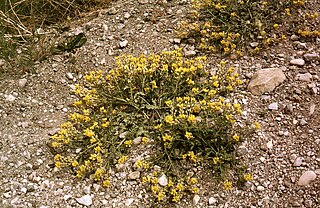
Rorippa columbiae is a species of flowering plant in the family Brassicaceae known by the common names Columbian yellowcress and Columbia yellow cress.

Rorippa curvipes is a species of flowering plant in the family Brassicaceae known by the common name bluntleaf yellowcress. It is native to much of western North America from Alaska to Mexico to the Mississippi River, where it can be found in various types of moist and wet habitat, including lakeshores and riverbanks, meadows, roadsides, mudflats, and irrigation ditches. It is an annual or perennial herb, producing several stems growing prostrate along the ground or somewhat upright, measuring 10 centimeters to around half a meter in maximum length. The leaves are long and narrow, smooth edged or lobed, the lobes sometimes cut all the way to the midrib or separated to form leaflets. Lower leaves are borne on petioles; upper leaves have bases that clasp the stem. The mustardlike flowers have very small yellow petals. The fruit is a plump, hairless silique containing many minute seeds.
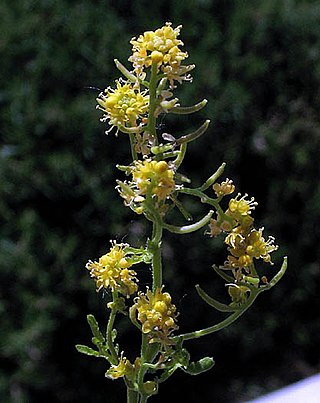
Rorippa curvisiliqua is a species of flowering plant in the family Brassicaceae known by the common name curvepod yellowcress.
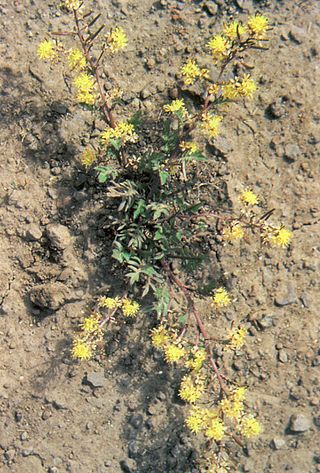
Rorippa sinuata is a species of flowering plant in the family Brassicaceae known by the common name spreading yellowcress. It is native to North America, including most all of the western and central United States, where it grows in many types of moist and wet habitat, such as lakeshores and riverbanks, meadows, and mudflats. It is a perennial herb producing spreading stems up to 40 or 50 centimeters long. It is densely hairy, the hairs rounded like sacs or vesicles. The leaves are up to 8 centimeters long and have blades are deeply toothed, lobed, or divided into smaller leaflets. The inflorescence is an elongated raceme occupying the top portion of the stem containing many tiny yellow flowers just a few millimeters long. The fruit is a curved silique which is variable in size and shape but generally contains many minute seeds.

Rorippa subumbellata is a rare species of flowering plant in the family Brassicaceae known by the common names Lake Tahoe yellowcress and Tahoe yellow cress. It is known only from the shores of Lake Tahoe, straddling the border between California and Nevada. There are an estimated fourteen populations of the plant still in existence. It grows only on the direct shoreline of the lake, occupying a seven-foot semi-aquatic zone between the high- and low-tide marks. It is directly impacted by recreational activities on the lake, enduring bombardment by boat wakes, trampling, and construction of docks and other structures.

Sanicula tuberosa is a species of flowering plant in the parsley family known by the common name turkey pea. It is native to western North America from Oregon through California to Baja California, where it can be found in many types of habitat, including chaparral, forests, and woodlands. It is variable in appearance. In general, it is a perennial herb producing a slender stem up to 80 centimeters long from a small, spherical tuber no more than 2 centimeters wide. The leaves are compound, divided into usually three leaflets which are smooth or deeply cut into lobes. The herbage is green to purple in color. The inflorescence is made up of one or more heads of bisexual and male-only flowers with tiny, curving, yellow petals. The fruits are 1 or 2 millimeters long and covered in bumpy tubercles.
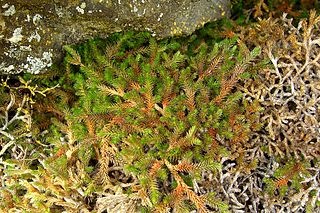
Selaginella wallacei is a species of spikemoss known by the common name Wallace's spikemoss. It is native to western North America from British Columbia to California to Montana, where it can be found in many types of habitat, including open and shaded areas, and wet to dry environments, often growing on and over rocks. This lycophyte is variable in appearance, its form depending on the habitat it grows in. It can be spreading with many narrow branches, or a small, dense mat. The forking stems grow up to about 25 centimeters long, but may remain much shorter in dry conditions. They are lined with linear, lance-shaped, or oblong leaves up to 4 millimeters long including the bristles at the tips. The strobili containing the reproductive structures may be quite long, reaching up to 9 centimeters.

Sibara filifolia, the Santa Cruz Island winged rockcress or Santa Cruz Island rockcress, is a rare species of flowering plant in the family Brassicaceae. It is endemic to the Channel Islands of California, where it is now known from a few occurrences on San Clemente Island and one population on Catalina Island.

Solidago multiradiata is a species of goldenrod known by the common names Rocky Mountain goldenrod, northern goldenrod, and alpine goldenrod. It is native to North America, where it can be found throughout the northern regions, including Alaska and most of Canada (all 3 territories plus all provinces except Prince Edward Island, including territory north of the Arctic Circle. Its distribution extends through the western United States as far south as Arizona, New Mexico, and California. It is known mostly from the subalpine and alpine climates of high mountain ranges. Its habitat includes tundra and mountain meadows.

Stellaria obtusa is a species of flowering plant in the family Caryophyllaceae known by the common names Rocky Mountain chickweed, blunt-sepaled starwort, and obtuse starwort. It is native to western North America, from British Columbia and Alberta to California to Colorado, where it grows in moist areas in forests and on mountain slopes.
Stellaria irrigua is a species of flowering plant in the family Caryophyllaceae known by the common names umbrella starwort and umbellate starwort. It is native to western North America from Alaska and north-western Canada to the south-western United States, as well as parts of Asia, including Siberia. It grows in subalpine and alpine climates in mountain forests and riverbanks. It is a rhizomatous perennial herb producing a slender prostrate stem up to about 20 centimeters long, sometimes forming clumps or mats. The stem is lined with pairs of oval leaves each up to about 2 centimeters long. The inflorescence is an umbel-shaped array of several flowers each on an arching or erect pedicels. The flower has five pointed green sepals each no more than 3 millimeters long. There are occasionally tiny white petals within the calyx of sepals, but these are generally absent.
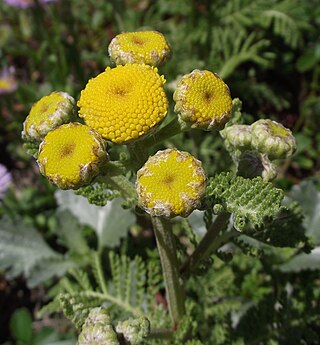
Tanacetum camphoratum is a species of flowering plant in the aster family known by the common names camphor tansy and dune tansy. It is native to the Pacific Coast of North America from British Columbia to California, where it grows in sand dunes and other coastline habitat. This species may be known by the synonym Tanacetum douglasii and is often included in Tanacetum bipinnatum. It is a rhizomatous perennial herb with a thick, low-lying stem up to 25 centimeters long, branching to form a mass of vegetation. It is hairy, glandular, and aromatic, with a camphor scent. The leaves are up to 25 centimeters long and thick but featherlike, divided into many narrow leaflets on each side of the main rachis. Each leaflet in turn has many segments along each side, and the segments are usually divided into several small, knobby segments with folded or curled edges. The inflorescence bears up to 15 flower heads, each about a centimeter wide or slightly wider. Each head contains many yellowish disc florets and many pistillate florets around the edges. The latter may have minute ray florets. The fruit is an achene a few millimeters long which is tipped with a small pappus of toothed scales.

Triteleia montana is a monocot flowering plant in the genus Triteleia. Its common names include Sierra triteleia, and mountain triteleia. It is endemic to California, where it is limited to the Sierra Nevada. It occurs in coniferous forests on granite soils. The Latin specific epithet montana refers to mountains or coming from mountains. It is a perennial wildflower growing from a corm. There are two or three basal leaves measuring up to 30 centimeters long and just a few millimeters wide. The inflorescence arises on an erect, rough-haired stem up to 25 or 30 centimeters tall. It is an umbel-like cluster of several flowers each borne on a pedicel up to 3 centimeters long. The flower is yellow with a dark midvein, and dries purplish. The funnel-shaped corolla is made up of six tepals up to a centimeter long each. There are six stamens with white or blue anthers.

Vicia hassei is a species of vetch known by the common names Hasse's vetch and slender vetch.

Sibaropsis is a monotypic genus of flowering plants in the family Brassicaceae containing the single species Sibaropsis hammittii, which is known by the common name Hammitt's clay-cress. It is endemic to California, where it is known from two locations in the Peninsular Ranges. The plant is known from the Santa Ana Mountains of Riverside County and Viejas Mountain and nearby peaks east of San Diego. It grows in grassy habitat in openings in chaparral alongside purple needlegrass, generally in moist areas in heavy clay soils. This species and its genus were first described to science in 1997.

Nasturtium gambellii is a rare species of flowering plant in the mustard family known by the common names Gambel's yellowcress and Gambel's watercress. It is known from three or four scattered occurrences in California. It is also native to central Mexico and Guatemala. Its total U.S. population was last estimated at fewer than 300 individuals. It was federally listed in California, as an endangered species of the United States in 1993.



















